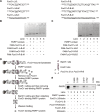Polymerase independent repression of FoxO1 transcription by sequence-specific PARP1 binding to FoxO1 promoter
- PMID: 31992690
- PMCID: PMC6987093
- DOI: 10.1038/s41419-020-2265-y
Polymerase independent repression of FoxO1 transcription by sequence-specific PARP1 binding to FoxO1 promoter
Abstract
Poly(ADP-ribose) polymerase 1 (PARP1) regulates gene transcription in addition to functioning as a DNA repair factor. Forkhead box O1 (FoxO1) is a transcription factor involved in extensive biological processes. Here, we report that PARP1 binds to two separate motifs on the FoxO1 promoter and represses its transcription in a polymerase-independent manner. Using PARP1-knock out (KO) cells, wild-type-PARP1-complemented cells and catalytic mutant PARP1E988K-reconstituted cells, we investigated transcriptional regulation by PARP1. PARP1 loss led to reduced DNA damage response and ~362-fold resistance to five PARP inhibitors (PARPis) in Ewing sarcoma cells. RNA sequencing showed 492 differentially expressed genes in a PARP1-KO subline, in which the FoxO1 mRNA levels increased up to more than five times. The change in the FoxO1 expression was confirmed at both mRNA and protein levels in different PARP1-KO and complemented cells. Moreover, exogenous PARP1 overexpression reduced the endogenous FoxO1 protein in RD-ES cells. Competitive EMSA and ChIP assays revealed that PARP1 specifically bound to the FoxO1 promoter. DNase I footprinting, mutation analyses, and DNA pulldown FREP assays showed that PARP1 bound to two particular nucleotide sequences separately located at -813 to -826 bp and -1805 to -1828 bp regions on the FoxO1 promoter. Either the PARPi olaparib or the PARP1 catalytic mutation (E988K) did not impair the repression of PARP1 on the FoxO1 expression. Exogenous FoxO1 overexpression did not impair cellular PARPi sensitivity. These findings demonstrate a new PARP1-gene promoter binding mode and a new transcriptional FoxO1 gene repressor.
Conflict of interest statement
The authors declare that they have no conflict of interest.
Figures





References
MeSH terms
Substances
LinkOut - more resources
Full Text Sources
Research Materials
Miscellaneous

